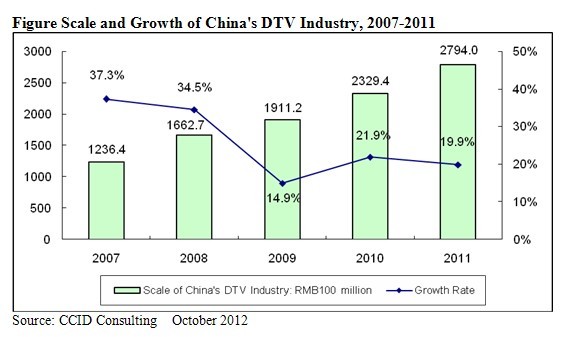DTV and Digital Home Seeing Overall Development in China
Friday, November 23rd, 2012BEIJING — With the increasing popularity of a digitalized, networked and intelligentized lifestyle, and the implementation of a package of policies in stimulating domestic demand such as Home Appliances Going to the Countryside and Home Appliances Replacement, China’s digital home industry has seen rapid development towards tri-network integration. Preliminary results have been achieved in industrial transformation and structural adjustment, and great progress has been made in the application innovation of digital home services featuring tri-network integration and represented by interactive entertainment, smart home and information service.
I. Industrial Scale
The development of China’s DTV industry in 2011 was mainly represented by cable DTV and IPTV, whereas terrestrial and satellite DTV experienced little growth. In 2011, the scale of China’s DTV industry reached RMB 279.40 billion, with a year-on-year growth of 19.9%.

II. Major Characteristics
1. The industry chain of digital home has taken shape
The industry chain of digital home mainly consists of manufacturers of chips, operating systems and other core components, complete-system vendors, Internet content providers (ICPs), network operators and end users.
At the end of the chain are household users. Complete-system vendors and network operators (cable television operators and telecom operators) interact with end users by selling final products and providing them together with services, and they are the center of product function and business model innovations. ICPs provide content support for network operators or complete-system vendors, and gain its revenues from profit sharing. Core component manufacturers serve as the basis of technical innovation in the entire industry chain.
2. Home entertainment solutions become the widest application
Currently, as an overall service, digital home solutions have not been widely applied in real life, especially in China. China’s digital home application focuses mostly on the interconnection and intercommunication of two or three kinds of information terminals, and the most widely-used application is the home entertainment solutions and products.
III. Trends
The next few years will be an important period for improving the interactive cooperation between key enterprises and SMEs in terms of digital home. The industry chain will further complete itself; cooperation among network operators, ICPs, system integrators and other institutions will be strengthened; and the whole industry will pay more attention to the R&D and promotion of the new digital home system which features the combination of tri-network integration, high-definition interaction and intelligent control.
1. Digital entertainment is the starting point in the development of digital home
In the next few years, the demand for home entertainment and the improvement of various solutions will drive the development of the whole digital home industry. The development of digital home products will have a great impact on the evolution of technologies. Meanwhile, digital home technologies will become high-definite, wireless and energy-saving. According to the survey of CCID Consulting, among the various applications of digital home, consumers’ tend to accept digital entertainment rather than smart home.
2. Cable DTV enterprises will have access to more investment
Over the next few years, the number of cable TV subscribers is expected to exceed 200 million in China, which presents great development potentials for network operators, ICPs as well as software and hardware equipment suppliers, and is bound to attract more investment. In addition, under the macro policy of expanding domestic demand, each DTV operator will have great opportunities to obtain financial support from the local governments and policy support of network integration, so as to accelerate digitization and bolster local consumption. Enjoying favorable policies, stable profit models, low debt ratios, sound operational cash flows, diversified financing channels, lack of industrial cyclical variation and other advantages, the DTV industry will gain more funds for its development.
Latest News
- Barb to start reporting TV-set viewing of YouTube channels
- SAT FILM selects multi-DRM from CryptoGuard
- Qvest and ARABSAT to launch OTT streaming platform
- ArabyAds & LG Ad Solutions partner with TVekstra in Turkey
- Freeview NZ satellite TV service to move to Koreasat 6
- Comscore expands YouTube CTV measurement internationally
